Dog Ear Infections – Learn How To Treat & Prevent
Dog ear infections are sadly one of the most common disease presentations that veterinarians see on a daily basis.Many dogs suffer from chronic ear inflammation (otitis externa) and this causes them a lot of pain and the owners a lot of frustration.It really doesn’t have to be this way.In this article, we want to teach you the methods to prevent your dog from having recurring ear infections and how to treat them if they do occur.Let’s get right to it.Video Tutorial: How To Manage Sore Ears
First Things First – What is Otitis Externa?
Otitis externa is an acute or chronic inflammation of the outer ear canal. It is the most common ear canal disease in dogs & cats.The term is used to describe clinical symptoms and is not a ‘disease’ itself.It occurs in response to a change in the normal environment of the ear canal which causes the glands lining the canal to enlarge and produce excessive wax. The ear canal becomes thickened and inflamed and this blocks how air and fluid flow in and out of the canal.How To Tell If Your Dog Has an Ear Infection?
Before we even start discussing treatments or prevention we need to understand the subtle signs that your dog might show that indicate that it may have an infected ear.For many dogs, the signs of sore ears are very subtle.Many dogs are so stoic, it’s not until they have advanced inflammation that many owners notice.Remember, dog ear infections are painful.The sooner you can recognise the pain, the quicker you can act and treat your dog.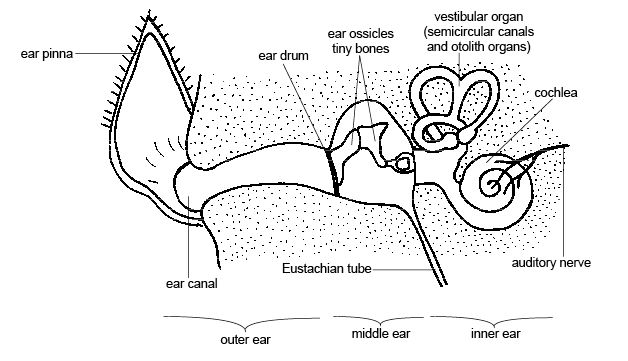
Anatomy of the dog’s ear. Sunshineconnelly at en.wikibooks [CC BY 3.0 (https://creativecommons.org/licenses/by/3.0)]
Initial Signs Of An Ear Problem
- shaking head
- pawing at an ear
- rubbing ear against furniture or the ground
- scratching ears
- avoiding touch to the head
More Advanced Signs Of An Ear Problem
- moving away from you
- hiding
- shaking if you approach
- ear discharge
- bad smell from ears
Signs Of An Inner Ear Problem (Otitis Interna)
- balance is affected and your dog may appear unstable and fall over
- they may walk in circles
- have a head tilt
- avoid eating on one side or at all
- reluctant to open mouth
- have a droopy mouth or eyelid
Ear Infections Are Always Painful
Dog Ear Problems Are Painful
I can’t think of one case where a dog with an ear problem isn’t painful, so I can’t emphasise this enough.EAR INFECTIONS ARE PAINFUL.Even if you aren’t sure, but think there might be a problem, that is enough reason to acknowledge that your pet will be in pain.It is NOT good enough to do absolutely nothing. You must act and you must seek veterinary advice.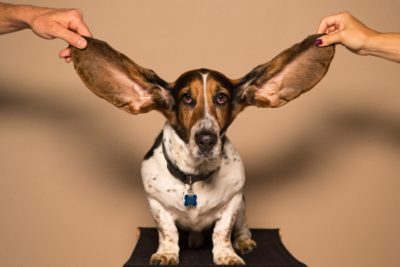
Dogs with pendulous ears are more prone to ear problems.
What Causes Dog Ear Infections?
There are a huge number of reasons that your dog may have sore ears. Not all of them are due to infection and the vast majority are caused by some other underlying problem.So while you might think the problem is just the ears, unfortunately for many dogs this is just not the case.When vets look at your dog’s ears, we are trying to solve two problems:
There are many reasons why a dog’s ears can become inflamed, and many of these are secondary to another underlying disease. The most common causes of otitis externa include:- the sore ears that are a problem at this moment in time
- the underlying cause that resulted in the ear problem in the first instance
- dog ear mites, other parasites
- secondary bacterial infection
- secondary fungal yeast infections
- a foreign body such as a grass seed in the ear canal
- a mass in the ear canal such as a tumour or polyp
- allergies (e.g. atopy, adverse food reaction, environmental). Even ear mites can stimulate an allergic reaction.
- conformation or hair problems i.e. dogs with pendulous ears like labradors or those with lots of hair like poodles
- endocrinopathies such as hypothyroidism
- drug reactions
- autoimmune diseases eg. pemphigus
What To Do If You Find That Your Dog’s Ears Are Sore
So you think your pet might have a problem with an inflamed ear?Perhaps you can’t look in their ear without them trying to bite you? Maybe the ear looks red? There might be a smell or discharge. Perhaps it looks black and gooey. What next?Remember how I said ears are painful. Well, They are SOOOOO PAINFUL that you MUST get your dog examined by a vet.ALL dogs with ear inflammation have ear pain and it is not something that can be avoided.Ear pain is like a headache that doesn’t go away.You need to take your dog to see a vet.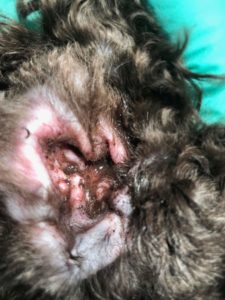
An inflamed ear with discharge. There is no way to guess what is causing this problem.
How Do Vets Treat Sore Ears
As I mentioned above, vets will need to do two things:- work out and fix what is causing the ear to be sore
- determine what the underlying cause is for the dog to have infected ears in the first case.
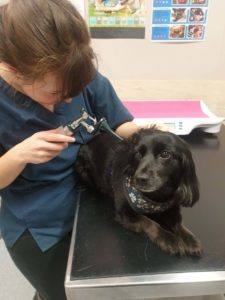
Examination of a dog’s ear using an otoscope.

Dr Leigh viewing ear cytology under a microscope.
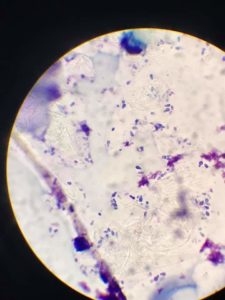
A cytology slide showing cells involved in dog with an infected ear.
Medications to Treat Sore Ears
All ear problems are painful so the mainstay of treatment is giving your dog relief of pain. In most situations, the vet will prescribe an ear drop that has an anti-inflammatory agent in it such as prednisone. If your dog is very painful, they may prescribe oral anti-inflammatories as well.Ear drops will likely contain an antibiotic combined with an anti-fungal agent and pain relief agent.The medication that your vet chooses will depend on the result of the cytology. This is why you can’t just rock up and ask for ear medications without a consult and cytology.Vets just don’t know what they are treating! I wish we had a crystal ball, but we don’t.What To Do At Home To Treat Ears
Your vet will send you home with medications to give your dog. It is vitally important to follow all instructions to the letter so that your dog can become pain-free and the cause of the pain stops.Most problems occur when people underdose the amount of medication they put in the dog’s ears.Remember – a dog’s ear canal holds about 1ml of fluid. That’s how much you need to put in your dog’s ears to treat the problem. Most bottles say 3-5 drops.THIS IS INCORRECT.Why Does My Vet Want My Dog Back For A Recheck?
Remember how I said earlier that we need to treat the sore ears first, THEN we have to find out why the ears are sore in the first place? Well, the reason for this is so that the ear infection doesn’t come back.Go back and take another look at why dogs get sore ears. It’s quite some list. If we fail to work out why your dog is getting sore ears, then your dog will keep getting them. It’s no fun for anyone.The ear recheck does a few things:- it confirms that the treatment has worked – the vet will do more cytology
- it gives the vet another chance to clean the ears
- it starts the process of determining what the underlying problem might be
How To Prevent Ear Infections
The best way to prevent recurring ear infections in dogs is with proper control and management of any underlying disease.For the vast majority of dogs that vets see in clinic, this means treating atopic dermatitis or food allergy problems.However, there are some things you can do at home to make sure your dog isn’t affected by sore ears.This includes:- cleaning the ears – less is more when it comes to cleaning ears, cleaning too frequently can cause stripping of natural oils. Get your vet’s advice on how frequently you need to do this.
- dry the ears after swimming or bathing. Alternatively, use cotton wool to plug your dog’s ears when bathing so that water doesn’t enter the canal.
- don’t allow anyone to pluck your dog’s ears. This is a BIG NO NO. Your vet may have to pluck the hair when treating, but that is the only time the hair in your dog’s ears should ever be touched.
Do you have problems with your dog’s ears? Our vets can always assist you with recommendations. Please note, we cannot prescribe medications for ear treatment as cytology must be performed.

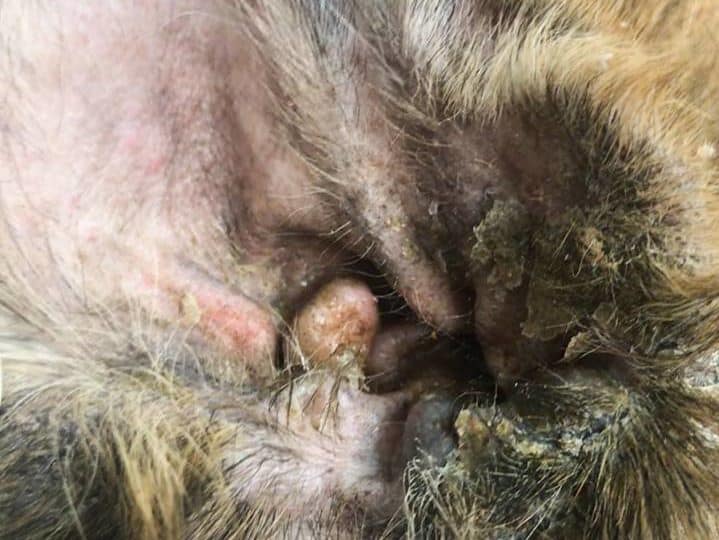


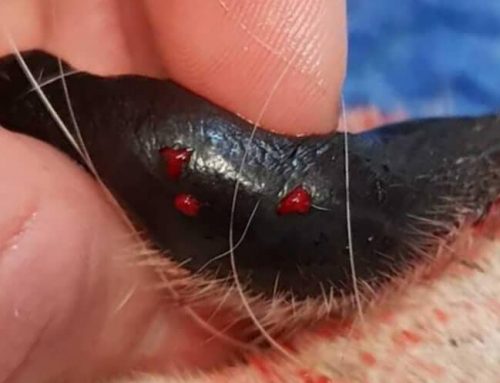
Leave A Comment